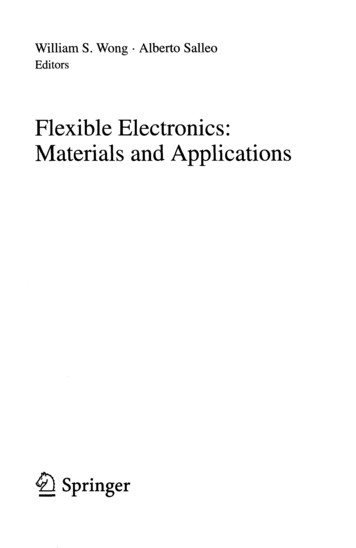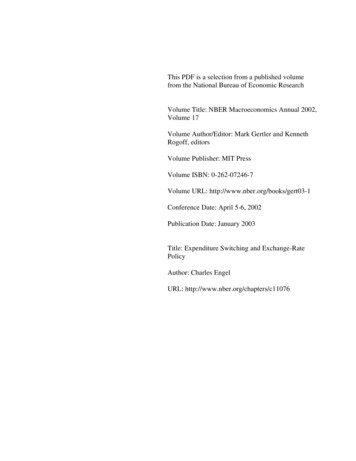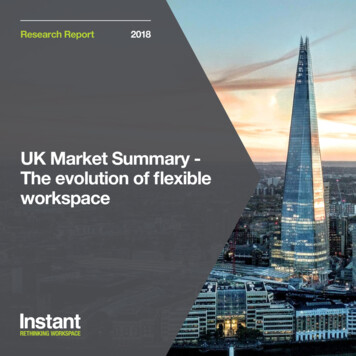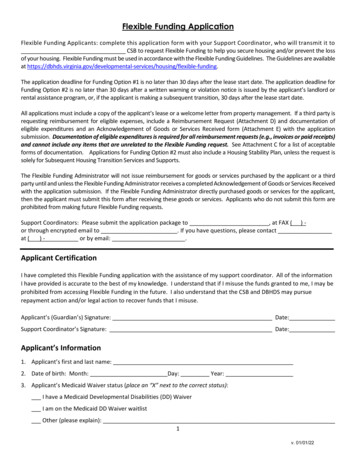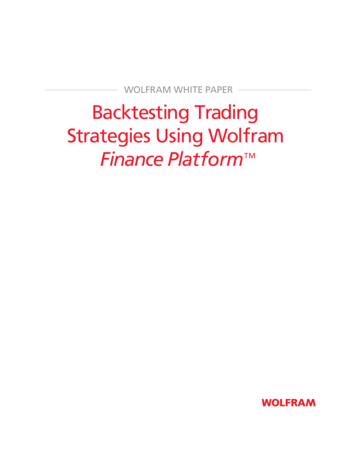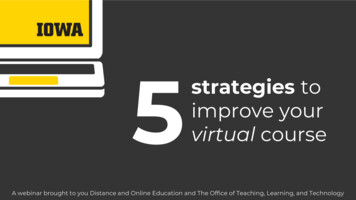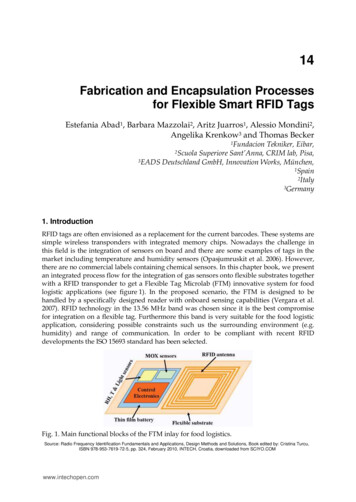
Transcription
Personalized LearningStrategy SpotlightUsing Flexible LearningStrategies to Foster Equitableand Inclusive EducationOpportunitiesAlise Crossland & Kristin Ruedel, American Institutes for Research
IntroductionWhat Do We Mean byFlexible Learning?School building closures due toCOVID-19 challenged educators torethink teaching and learning. Althoughemergency remote teaching and learningis just a snapshot in time, the lessonslearned will continue to echo throughouteducation beyond the COVID-19 crisis.The shift to remote learning exposedsignificant areas of need for students,teachers, and families. Further, the shiftunderscored gaps in equity of accessto technology, broadband internetservice, and learning resources and theimportance of flexibility and adaptabilityin how we approach learning.As students and teachers have shiftedfrom setting to setting (e.g., remote,hybrid, in-person), educators haverecognized the critical need to developsystems, teaching strategies, andcontent that is flexible and can shifteasily across settings. The benefitsassociated with providing students with“voice and choice” in when, where, andhow they learn are far-reaching, and canhelp prepare all learners with the skillsthey need to succeed in an increasinglycomplex world.In this Personalized Learning StrategySpotlight, we provide an overview offlexible learning strategies, suggestionsfor implementation, and examples offlexible learning in practice. As districtscontinue to explore approaches forresponding to the COVID-19 crisis, AIRhopes that this Spotlight will providedistrict and school leaders with tools forbuilding more flexible and personalizedlearning opportunities for all students inall settings.Flexible learning is a student-centeredapproach that provides students withchoice in what they learn, how theylearn, and when and where they xible learning environments fallunder the umbrella of flexible learningmethods and include the design ofphysical spaces, scheduling, and studentgroupings to (a) encourage activelearning and personalized instructionand (b) provide space and opportunitiesfor students to create, problem solve,and collaborate with peers. Flexiblelearning environments are often usedas part of a strategy to support theimplementation of other studentcentered and personalized learningstrategies.
Design Elements ofFlexible LearningFlexible learning strategies often referto the design of physical spaces as amechanism for supporting studentcentered learning and personalizedinstruction. For example, specificclassroom arrangements can encourageor discourage certain types of learningand engagement. A physical classroomwith space for collaborative work createsan environment that supports sharing andpeer-to-peer learning. An online learningenvironment might make use of breakoutrooms, chat features, and collaborativeworkspaces to support peer-to-peerlearning opportunities. Whether inperson, virtual, or hybrid, teachers usethe design of learning spaces, schedules,and instruction to create opportunities formore personalized learning.This content was developed as a result of districtinterviews conducted under a grant from the U.S.Department of Education, #H327T180001. However,the contents do not necessarily represent the policyof the U.S. Department of Education, and you shouldnot assume endorsement by the Federal Government.Project Officers: Tara Courchaine, Ed.D., and AnitaVermeer, M.Ed.1See it in ActionCommonwealth Charter Academy(CCA) is a K–12 virtual charter schoolin Pennsylvania. CCA grounds itsinstruction in Universal Design forLearning, creating multiple ways topersonalize instruction and multipleopportunities for students to engagewith content and demonstrateunderstanding. CCA uses a varietyof technology tools and supports tocreate flexible options for studentgroupings, schedules, student responseand engagement, and learning settings.For example, during synchronousinstruction, teachers use formativeassessment data to group students fortargeted instruction in small breakoutgroups. Teachers also use these data toadapt instruction, content, and lessonpacing. Live lessons are recorded,providing students with flexibility inwhen and how they learn; studentscan elect to attend a synchronouslesson or watch the recorded session.This approach gives students (a)the flexibility they need to scheduleinstruction that aligns with their needsand (b) the ability to control pacing ofinstruction (e.g., slow down, speed up,or rewatch). Formative data are alsoused to create asynchronous instruction,which also offers flexible lessonoptions. With asynchronous instruction,lessons are created with built-inmodifications, accommodations, andscaffolds according to student needs toensure each student has the supportsneeded to access content and achievemastery. These options may includeadditional audio or video support oradditional context to help students buildbackground knowledge.
Why FlexibleLearning?Flexible learning and the design offlexible learning environments arestrategies that can help districts tosupport more personalized learning forstudents.In flexible learning environments,pedagogies are driven by These environments are also groundedin research in how people learn.Although the design of a flexiblelearning environments stretches beyondrearranging furniture and physicalspaces, districts may find that startingwith attention to the physical (or virtual)space that students learn results inripple effects for how districts thinkabout staffing, physical spaces, teachercollaboration, scheduling, allocationof resources and technology, and thedesign of professional development.Thinking about how to create thelearning environments for students to bemore engaged and collaborative learnersrequires a shift in teaching practices tocreate a learning environment that isbased on inquiry and personalized tomeet the needs of both teachers andstudents.Fostering student independence andagency (the ability to make choicesand take an active role in learning); Encouraging collaborative learning; Approaching teaching as a processof constructing knowledge, makingmeaning, and making connectionsacross learning areas.Why should districts focus on designingflexible learning environments? The useof flexible learning strategies have shownpromise in improving academic andnonacademic outcomes for students,including Supporting active and collaborativelearning; Addressing learner variability andstudents with a variety of learningneeds and preferences; Preparing students with skills for workand education in the 21st century; Improving learner motivation andengagement; Increasing collaboration, cooperation,and communication; and Improving classroom culture,management and student behavior(Barrett et al., 2015; Crum, 2019;Daviesa et al., 2012; Kariippanon et al.,2019; Pane 2018; Pane et al., 2015).
See it in ActionLike districts throughout the UnitedStates, Loudoun County PublicSchools in Loudoun County, Virginia,had to make a rapid transition toremote learning in response to theCOVID-19 pandemic. The district hadpreviously focused on implementing anapproach to learning opportunities inphysical classrooms—using adjustableseating and spaces to encouragemore collaboration, flexible studentgroupings, and opportunities forhands-on project-based learning.Although this flexible approach did notmake the transition to remote learningeasy, the gradual shift in mindsettoward flexible instruction in the yearsbefore the COVID-19 pandemic helpedto support the transition to remotelearning. The district noted that theseinitiatives had been in progress beforethe pandemic, but “the virus is anaccelerator” that reinforced the criticalneed for collaboration, relationshipbuilding, accessible technology,and engagement with students andfamilies.The concepts of flexibility, agency, andstudent-centered learning are furthersupported by the science of learningand the variability among learners.Research on the science of learningsupports (a) the use of teachingstrategies that support deeper learning,encourage students to see themselvesas active and reflective learners and (b)the creation of classroom cultures thatsupport inquiry, exploration, and risktaking (Osher et al., 2017).Teachers are already using many ofthe teaching strategies employed inflexible learning models, including directinstruction, small and large group work,investigations, inquiries, self-and peerassessment, student reflection, andindependent and collaborative work. Thekey to personalizing these strategies isthe intentional design and interaction ofphysical and virtual spaces, curriculum,time, and staff to support a pedagogicalshift from teacher-led to studentcentered instruction. For example, todifferentiate instruction, educators canimplement “station rotation,” whichprovides students with opportunities toaccess learning through different activitycenters. For more information on usingthis approach to flexible learning, seeAIR’s Practitioner Brief, PersonalizingLearning With Station Rotation ce: This content was developed as a result of district interviews conducted under a grant from the U.S.Department of Education, #H327T180001. However, the contents do not necessarily represent the policy of the U.S.Department of Education, and you should not assume endorsement by the Federal Government. Project Officers:Tara Courchaine, Ed.D., and Anita Vermeer, M.Ed.2
Implementing FlexibleLearning in Your DistrictFlexible learning strategies can helpsupport districts in their efforts topersonalize learning and promotestudent agency and active learning,whether online or in the classroom.Flexible learning methods to personalizeinstruction can also help districts toaddress learner variability in a moreinclusive learning environment, bybuilding in student voice and choice inthe ways in which students learn, engagewith content, and demonstrate whatthey know.Planning for flexible environmentsrequires a shift in mindset and culture, asthe roles of both teachers and studentsshift from teacher-led instruction tostudent-centered and student-ledlearning. Although implementing flexiblelearning methods (physical space design,furniture, and instructional settings)can drive changes to pedagogy,teachers need additional professionaldevelopment and coaching support tomake these transitions. Flexible learningspaces and flexible groupings do notimprove student outcomes becausea district buys new furniture andrearranges seats. Instead, these flexiblespaces encourage and require new waysof thinking about teaching and learningand changes in the teacher-studentand student-student relationships. Hereare some questions that your districtteam might consider as you plan forimplementing more flexible learningstrategies in your district include: What is the relationship betweenphysical and/or virtual space andpedagogy? What teaching strategiesmight be needed to make flexiblespaces successful? How can we implement moreflexibility in our allocation of staff,resources, and time? What teachingstrategies might be possible withmore flexible scheduling? How can we extend flexible spaces,groups, and scheduling to the waywe design learning pathways forstudents? How can we make contentmore flexible? How can we extend flexibilityinto online and hybrid learningenvironments in the event of futureremote learning?
As districts and families continue toface uncertainty in how, when, andwhere learning happens, flexiblelearning strategies are critical forcreating more equitable, personalized,and inclusive experiences for allstudents in all settings. The followingresources from AIR can support yourdistrict in implementing flexible learning: Strategy Reflection: PersonalizingStudent Learning: eflection-PersonalizedLearning-2020.pdf Personalized Learning: VisioningTool: edLearning-visioning-tool-2020.pdf West Valley School District,Yakima Washington (PersonalizedLearning Spotlight): -School-District-spotlight-PLSeptember-2020.pdf
ReferencesBarrett, P., Davies, F., Zhang, Y., & Barrett,L. (2015). The impact of classroomdesign on pupils’ learning: Final resultsof a holistic, multi-level analysis. Buildingand Environment, 89, 118–133.Crum, B. (2019, June 22). Researchersexpanding flexible learningenvironment study at Midway schools.Waco Tribune Herald. idway-schools/article cd6bb8a9203c-51f3-9e84-0b3bf2eb61a5.htmlDaviesa, D., Jindal-Snapeb, D., Collier,C., Digbya, R., Haya, P., & Howea, A.(2012). Creative learning environmentsin education—A systematic literaturereview. Centre for Research in EarlyScientific Learning.Kariippanon, K. E., Cliff, D. P., Lancaster,S. J., Okely, A. D., & Parrish, A. M. (2019).Flexible learning spaces facilitateinteraction, collaboration and behaviouralengagement in secondary school. PloSone, 14(10), e0223607. https://doi.org/10.1371/journal.pone.0223607Osher, D., Cantor, P., Berg, J., Steyer, L.,Rose, T., & Nolan, E. (2017). Science oflearning and development: A synthesis.American Institutes for Research.Pane, J. F. (2018). Strategies forimplementing personalized learningwhile evidence and resources areunderdeveloped. RAND /PE314.htmlPane, J. F., Steiner, E. D., Baird, M. D.,& Hamilton, L. S. (2015). Continuedprogress: Promising evidenceon personalized learning. RANDCorporation. https://www.rand.org/pubs/research reports/RR1365.html
Commonwealth Charter Academy (CCA) is a K-12 virtual charter school in Pennsylvania. CCA grounds its instruction in Universal Design for Learning, creating multiple ways to personalize instruction and multiple opportunities for students to engage with content and demonstrate understanding. CCA uses a variety of technology tools and supports to
